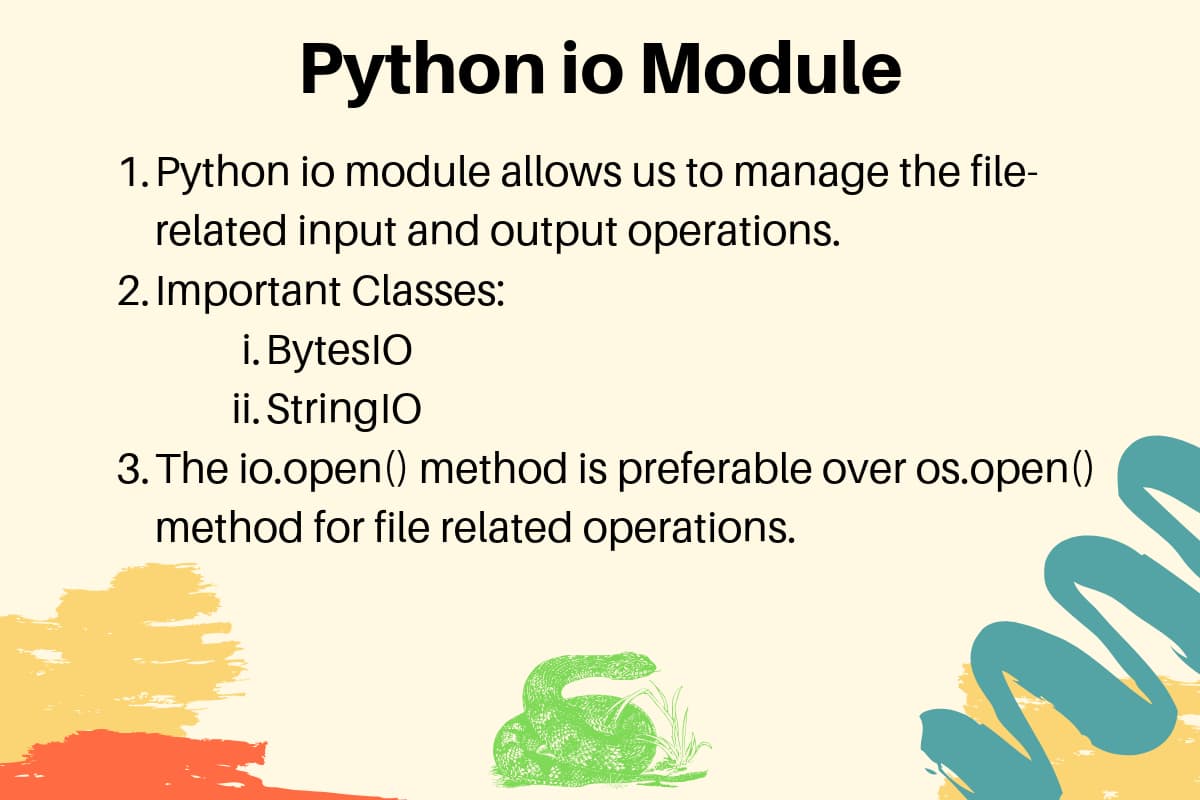- Log in to:
- Community
- DigitalOcean
- Sign up for:
- Community
- DigitalOcean

Python io module allows us to manage the file-related input and output operations. The advantage of using the IO module is that the classes and functions available allows us to extend the functionality to enable writing to the Unicode data.
Python IO Module
There are many ways in which we can use the io module to perform stream and buffer operations in Python. We will demonstrate a lot of examples here to prove the point. Let’s get started.
Python BytesIO
Just like what we do with variables, data can be kept as bytes in an in-memory buffer when we use the io module’s Byte IO operations. Here is a sample program to demonstrate this:
import io
stream_str = io.BytesIO(b"JournalDev Python: \x00\x01")
print(stream_str.getvalue())
Let’s see the output for this program:  The
The getvalue() function just takes the value from the Buffer as a String.
Python StringIO
We can even use StringIO as well which is extremely similar in use to BytesIO. Here is a sample program:
import io
data = io.StringIO()
data.write('JournalDev: ')
print('Python.', file=data)
print(data.getvalue())
data.close()
Let’s see the output for this program:  Notice that we even closed the buffer after we’re done with the buffer. This helps save buffer memory as they store data in-memory. Also, we used the print method with an optional argument to specify an IO stream of the variable, which is perfectly compatible with a print statement.
Notice that we even closed the buffer after we’re done with the buffer. This helps save buffer memory as they store data in-memory. Also, we used the print method with an optional argument to specify an IO stream of the variable, which is perfectly compatible with a print statement.
Reading using StringIO
Once we write some data to the StringIO buffer, we can read it as well. Let’s look at a code snippet:
import io
input = io.StringIO('This goes into the read buffer.')
print(input.read())
Let’s see the output for this program: 
Reading file using StringIO
It is also possible to read a file and stream it over a network as Bytes. The io module can be used to convert a media file like an image to be converted to bytes. Here is a sample program:
import io
file = io.open("whale.png", "rb", buffering = 0)
print(file.read())
Let’s see the output for this program:  For this program to run, we had a whale.png image present in our current directory.
For this program to run, we had a whale.png image present in our current directory.
io.open() vs os.open()
The io.open() function is a much preferred way to perform I/O operations as it is made as a high-level interface to peform file I/O. It wraps the OS-level file descriptor in an object which we can use to access the file in a Pythonic way. The os.open() function takes care of the lower-level POSIX syscall. It takes input POSIX based arguments and returns a file descriptor which represents the opened file. It does not return a file object; the returned value will not have read() or write() functions. Overall, io.open() function is just a wrapper over os.open() function. The os.open() function just also sets default config like flags and mode too while io.open() doesn’t to it and depends on the values passed to it.
Conclusion
In this lesson, we studied simple operations of python IO module and how we can manage the Unicode characters with BytesIO as well. However, if you are looking for complete file operations such as delete and copy a file then read python read file. Reference: API Doc
Thanks for learning with the DigitalOcean Community. Check out our offerings for compute, storage, networking, and managed databases.
Still looking for an answer?
- Table of contents
- Python IO Module
- io.open() vs os.open()
- Conclusion
Deploy on DigitalOcean
Click below to sign up for DigitalOcean's virtual machines, Databases, and AIML products.
Become a contributor for community
Get paid to write technical tutorials and select a tech-focused charity to receive a matching donation.
DigitalOcean Documentation
Full documentation for every DigitalOcean product.
Resources for startups and SMBs
The Wave has everything you need to know about building a business, from raising funding to marketing your product.
Get our newsletter
Stay up to date by signing up for DigitalOcean’s Infrastructure as a Newsletter.
New accounts only. By submitting your email you agree to our Privacy Policy
The developer cloud
Scale up as you grow — whether you're running one virtual machine or ten thousand.
Get started for free
Sign up and get $200 in credit for your first 60 days with DigitalOcean.*
*This promotional offer applies to new accounts only.
